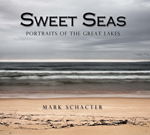When the first European explorers saw The Great Lakes they called them les mers douces — the sweet seas. They had never before encountered anything comparable. For the First Nations the Great La
When the first European explorers saw The Great Lakes they called them les mers douces — the sweet seas. They had never before encountered anything comparable. For the First Nations the Great Lakes have long been places of wonder and mystical power. And today the Lakes still have an ability to fascinate. Acclaimed photographer Mark Schacter travels the Great Lakes system to produce a personal portrait of the lakes and their surrounding towns, cities, ports, industrial zones and landscapes.
Reviews:
Mark Schacter's Sweet Seas is a visual tour of the delicate beauty and intense history of exploitation in and around the five Great Lakes. . . Sweet Seas is a remarkable study of how nature and humans merge together and create ever-changing landscapes."
— Canadian Geographic
"Mark Schacter was blessed with a perceptive eye and a lens that captures the Great Lakes in so many ways."
— shelflifemag.com
From the Introduction by Mark Schacter:
"The story of the Great Lakes has been written by two irresistible forces. First came the gigantic sheets of ice from the lst ice age that created the Lakes. Then came industrial-age man with ambition, short-sightedness, greed, technology and engineering prowess that have come close to destroying the Lakes, and have certainly altered them in ways that are irreversible. My interest was in the latter irresistible force, and so my photographic eye was focused mostly on man's interaction with the Lakes. You will find few images in this collection where there is no direct or indirect sign of human presence. Indeed it is difficult to escape the human imprint as you travel around the Great Lakes. This is no surprise: the region has been North America's industrial heartland for well over a century.
View Excerpt from book
I was born in Thunder Bay — a remote city in northwestern Ontario in the heart of the Canadian Shield. I left when I was 16, but the place has left a lasting impression on how I see the world and how I translate that vision into photography.
As a boy, accompanying my father on long road trips related to his business, I grew to love the rugged and empty northwestern Ontario landscape that was dotted with signs of feeble-looking human intervention. A lonely gas station, a makeshift paper mill town, an abandoned gold mine, the single-lane TransCanada highway: they seemed puny against the backdrop of billion-year-old pre-Cambrian bedrock, the big lakes and rivers, and the legions of blackflies and mosquitoes that were such an urgent reminder of nature's power over man.
Those boyhood impressions stuck with me for life. Much of my photography attempts to convey the smallness, frailty and transience of man's work in relation to the indifferent grandeur of the natural world.
View Biographical note

